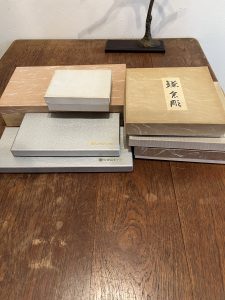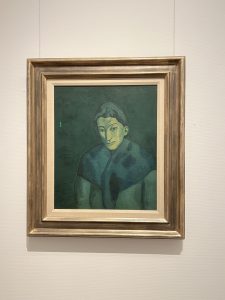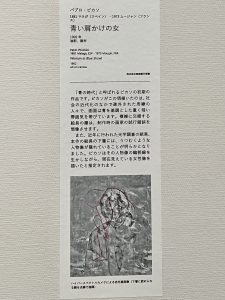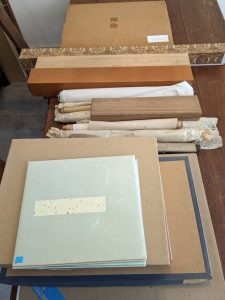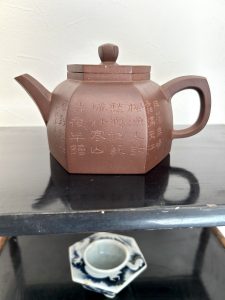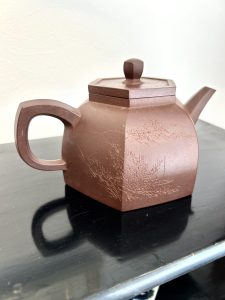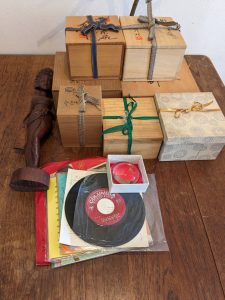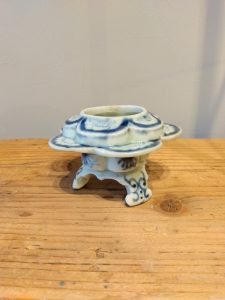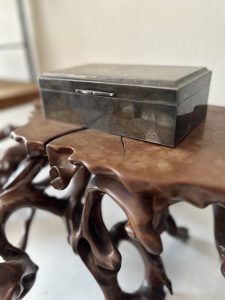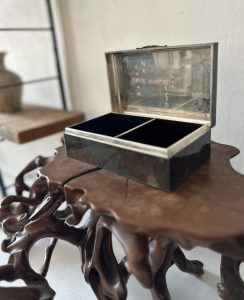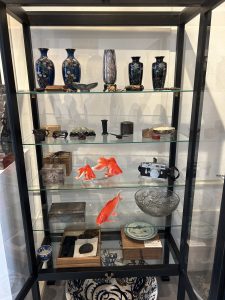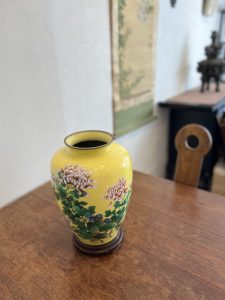皆さまこんにちは、スタッフYでございます。
気がつけば、道路脇やお宅の玄関先などの紫陽花が開花の準備に差し掛かっていたり、もう咲いているものもあったり。このところ季節が爆速で移り変わって、いよいよ暑い時節に移っていく感じがいたします。もう少しまってくれよ…と、言いたくなる気分でありますが、とはいえ、私の大好きな紫陽花がいろいろなところでいろいろな花をつけて咲いていくのこの季節は楽しみであります。
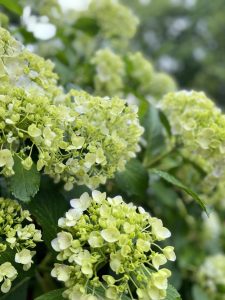
さてさて、先日から刀剣のお話をしておりますが、引き続き刀剣のつぶやきをしていきたいと思いますので少々お付き合いくださいませ。
ところで、国宝の工芸品に分類される文化財の中でも、その数が多い(約半数)のが刀剣(日本刀)ということをご存知だったでしょうか(太刀、大太刀、短刀など。剣や槍、薙刀も広義には含まれる)。そのうち「名物」と称されるもの、固有の名称(号)を持つ太刀は14振りでして、名物の刀剣は、名(号)と刀工の名「銘」を併せて呼ばれるが多いのですが、たとえば、三日月(号)+宗近(銘)など銘刀はこのような呼びます。なんだかその銘からすでにその佇まいの緊張感が伝わりますね。
また、日本刀を作る(鍛刀)「刀工」は、地域や特徴により流派「刀派」に分類されますが、刀派では山城国来派(らいは)、粟田口派、備前長船(おさふね)派、備前福岡一文字派、備中古青江派、三条などがあり、刀工は「安綱」「宗光」「来国光」「吉光」「長光」「国重」「左文字」「兼貞」「村正」「肥前国忠吉」「正宗」「虎徹」「貞次」「光世」などが著名であります。
その中でも日本刀の中でも特に銘刀とされるものにご存じの方もお出ででしょうが「天下五剣」。その中で国宝に指定されている3点は「三日月」「童子切」「大典太」、御物の「鬼丸」、重要文化財の「数珠丸」の5剣のことを「天下五剣」と呼びます。なお、5振とも日本刀の分類上は「太刀」であります。(※「御物」とは皇室の所有品のことで、宮内庁が所蔵する。)
諸説ありますが、室町時代の頃にはすでに”天下五剣”という言葉は使われていたようでして、完全に定着したのは明治以降とされています。室町時代にはすでに銘刀が価値あるものとして大切に受け告げれて来たようです。
それでは簡単ではありますが、天下五剣の詳細について説明いたしましょう。
1.童子切安綱(どうじぎりやすつな)
童子切安綱は平安時代の刀工、「大原安綱(おおはらやすつな)」作の太刀で、東京国立博物館が所蔵する国宝。平安時代末期に作られたといわれる名刀、「大包平(おおかねひら)」と共に、日本刀の「東西の両横綱」と賞賛されており、刃長は約80cm・反りは約2.7cmの太刀で、「驚くような切れ味」を誇る刀としても有名であります。
その切れ味は、試し切りの達人「町田長太夫」が折重なった罪人6人の遺体に対して、「童子切」を振りかざすと一刀で切断したうえに、下の土台まで刃が斬れ込んだという逸話があるほどですので、ちょっと怖い。
童子切安綱といえば、平安時代中期の武将である「源頼光」が、丹波国大江山に棲みついて人々を困らせた非常に凶悪な鬼、「酒呑童子(しゅてんどうじ)」の首を切り落としたという伝説もある刀です。その伝説が由来となり、「童子切」の号が付けられたといわれたということで、このように伝説的なエピソードが名前になることもあるんですね。童子切安綱は年1回程度のペースで、東京国立博物館にて展示されています。
2.鬼丸国綱(おにまるくにつな)
鬼丸国綱は鎌倉時代の刀工、「粟田口国綱(あわたぐちくにつな)」作の太刀で、天下五剣で唯一となる皇室の所有品「御物(ぎょぶつ)」であります。「粟田口一門」は鬼丸を始め、多数の著名作を作刀したことで有名。刃長は約78cm・反りは約3.2cmの太刀で、鬼丸国綱は北条家の重宝として知られる刀であります。「鬼丸」という号は、鎌倉幕府5代執権「北条時頼」が鬼の悪夢に苦しめられるという怪事を、この刀を手にしたことで払ったという古伝に由来したものでして、これまた伝説的エピソードの銘ですね。
そのため、鬼丸国綱のことを「鬼切りの太刀」というイメージを持たれている方も少なくはありません。また、この刀の所有家は戦に破れてきたという縁起の悪さを忌み嫌い、無類の日本刀好きである豊臣秀吉でさえ、この刀の所有を避けたという伝来もあります。
また、「御物」という性格上、天下五剣の中では唯一、鬼丸国綱のみ「国宝」及び「重要文化財」としての文化財指定を受けておりません。一般向けに展示される機会が非常に限られているため、書籍などに掲載される写真も数少ない機会に撮影されたものに限られております。
3.三日月宗近(みかづきむねちか)
三日月宗近は平安時代の刀工、「三条宗近(さんじょうむねちか)」作の太刀で、東京国立博物館が所蔵する国宝です。三条宗近は山城国京の三条に住んでいたことから、「三条宗近」という呼称がありますが、平安時代末期の名工として知られております。
天下五剣の中で”最も美しい”と評される優美な刀で、「名物中の名物」といわれ続ける名刀です。
刀剣にあまり詳しくない方でも、「三日月」のことは知っているという方も少なくありませんよね。
「三日月」という号は、刀身に三日月形の模様が浮き出ていることが、由来として伝えられております。刃長は約80cm・反りは約2.7cmの太刀で、足利家の重宝だったと伝えられていますが、長く徳川将軍家に伝来したことでも知られており、三日月宗近も年1回程度のペースで、東京国立博物館にて展示されています。
4.大典太光世(おおでんたみつよ)
大典太光世は平安時代の刀工、「三池典太光世(みいけでんたみつよ)」作の太刀で、東京都目黒区にある公益財団法人の前田育徳会が所蔵する国宝。元々は足利将軍家に伝来する宝刀でしたが、豊臣秀吉の手を経て前田利家に渡り、現在に至るまで前田家が代々守っている名刀であります。刃長は約66cm・反りは約2.7cmの太刀で、他の太刀と比較すると短めの刀身と、広い身幅が特徴。
「大典太」という号は、前田家が所蔵する「典太光世」作の刀剣には「長いもの」と「短いもの」が二振りあり、単純に長い方を「大典太」と呼んでいたことに由来しています。病気や妖かしからの守護ができる霊刀としても知られ、秀吉の養女「豪姫」の病気を治したり、伏見城で妖かしを退けたという言い伝えも残されています。
5.数珠丸恒次(じゅずまるつねつぐ)
数珠丸恒次は鎌倉時代の刀工、「青江恒次(あおえつねつぐ)」作の太刀で、兵庫県尼崎市にある本興寺が所蔵する国の重要文化財。鎌倉時代の僧で日蓮宗の開祖である、「日蓮」が所持していたとされる刀で、身延山に配流された際、信者から護身用に贈られたと伝えられております。
日蓮は贈られたこの太刀の柄に数珠を巻き、武器としてではなく魔除けの守り刀として用いていたことは著名な話です。「数珠丸」という号は、このエピソードが由来しているともいわれています。刃長は約81cm・反りは約3cmある太刀で、天下五剣の中で”最も長い”のが特徴。
この数珠丸恒次(じゅずまるつねつぐ)ですが、日蓮の没後数珠丸は長らく所在不明となりましたが、宮内省の刀剣研究家「杉原祥造」氏が、ある華族の競売の中になんと数珠丸があるのを発見。
自身の私財を投じて数珠丸を落札し、日蓮にゆかりのある「身延山久遠寺」へ返還を申し出ますが、真贋が定かではないことからこれを断られたとのこと。
「杉原祥造」氏は仕方なく、当時自宅の近くにあった日蓮宗の寺院「本興寺」に相談。その結果、現在に至るまで「本興寺」に奉納されることになったとこのと。
いやあ、是非拝見してみたいですね…。と、呟きたいところなのですが、実は2年前の東京国立博物館の「国宝展」にて、童子切安綱(どうじぎりやすつな)、三日月宗近(みかづきむねちか)を拝見することができたのですが、銘刀を前にしてどんな気分だったか?
展示の仕方も素晴らくなおさらだったのですが、まずは何も考えず全体の形を拝見し、さらに刃の景色を眺めておりますと、景色の中にすーっと引き込まれていくような感覚をとても覚えております。
こと、三日月宗近(みかづきむねちか)の刃に広がる三日月を眺めておりますと、刃の中に確かに薄墨の夜景に浮かぶ三日月が。ずぶの素人ではありますが「これが景色がみえるということなのか…。」などと感銘を受けました。また、ほど述べた説明のように有名な武将たちもこの刃先や景色に引き込まれていったのかと思いますと、それはテンションがあがります。あの刃の輝きと共に今でも記憶に鮮烈に焼き付いていますので、こうやって人は刀剣に沼っていくのでしょうね。
それではごきげんよう。
Hello everyone, this is Staff Y.
I noticed that the hydrangeas on the side of the roads and at the entrance of houses are getting ready to bloom, and some of them are already in bloom. It feels like the season is changing at a blinding speed and we are finally moving into the hot season. I feel like saying, “Wait a little longer…” However, I am looking forward to this season when my favorite hydrangea blooms in various places with various flowers.
Now, I have been talking about swords since the other day, and I would like to continue tweeting about swords, so please bear with me for a while.
By the way, did you know that among cultural properties classified as national treasures, swords (Japanese swords) are the most numerous (about half) (Tachi, Otachi, Daitachi, Tanto, etc…)? (Swords, spears, and naginata are also included in a broad sense.) There are 14 swords that are called “Meimono,” or swords with a unique name (No.). Meimono swords are often referred to by both the name (No.) and the swordsmith’s name (inscription). For example, a sword with the inscription “Mikazuki (No.) + Munechika (inscription)” is called in this way.
The swordsmiths who make (forge) Japanese swords are classified into schools or schools of swordsmanship according to region and characteristics. The most famous swordsmiths are “Antsuna”, “Munemitsu”, “Raikokumitsu”, “Yoshimitsu”, “Nagamitsu”, “Kunishige”, “Saumonji”, “Kanesada”, “Muramasa”, “Hizen-no-Kuni Chukichi”, “Masamune”, “Toratoru”, “Teiji” and “Mitsuyo”.
Among these, there are five swords known as “Tenka Goken,” which some of you may know as the most famous swords in Japan. The five swords are Mikazuki, Dojikiri, and Odonta, three of which are designated as national treasures, Onimaru, a Gomotsu sword, and Sujumaru, an important cultural property. All five swords are classified as “Tachi” in the Japanese sword classification. (*“Gomotsu” refers to items owned by the Imperial Household and held by the Imperial Household Agency.)
There are various theories, but it is said that the term “five swords under heaven” was already in use during the Muromachi period (1333-1573), and it was only after the Meiji period (1868-1912) that the term was fully established. In the Muromachi period, it is said that the swords were already considered valuable and valued.
Let me briefly explain the details of the Five Swords of Heaven.
Dojigiri Yasutsuna
Dojigiri Yasutsuna is a national treasure owned by the Tokyo National Museum and was made by Ohara Yasutsuna, a swordsmith of the Heian period. It is a national treasure owned by the Tokyo National Museum. Along with the Ookanehira, a famous sword said to have been made in the late Heian period (794-1185), it is praised as the “double grand champion of the East and West” of Japanese swords, with a blade length of about 80 cm and a warp of 2.7 cm, and is famous as a sword with “amazing cutting ability.
The blade is so sharp that there is an anecdote that “Machida Chotao,” a master of test cutting, cut off the bodies of six criminals with a single swing of the “Dojikiri” and the blade even cut into the foundation below, which is a bit scary.
Speaking of the Dojikiri Yasutsuna, legend has it that “Minamoto no Yorimitsu,” a military commander in the mid-Heian period, cut off the head of “Shuten Doji,” a very vicious demon who lived in Oeyama in Tamba Province and annoyed people. It is said that the name “Dojikiri” was given to the sword because of this legend, and so legendary episodes can become the name of a sword in this way. Dojikiri-Yasutsuna is exhibited at the Tokyo National Museum about once a year.
2. Onimaru Kunitsuna
Onimaru Kunitsuna is a tachi sword made by Awataguchi Kunitsuna, a swordsmith of the Kamakura period (1185-1333), and is the only one of the Five Swords of Japan owned by the Imperial Family. The Awataguchi clan is famous for having produced many famous swords, including Onimaru. Onimaru Kunitsuna is a sword with a blade length of approximately 78 cm and a warp of approximately 3.2 cm, and is known as a treasured sword of the Hojo family. The name “Onimaru” is derived from an old legend that the fifth regent of the Kamakura Shogunate, “Hojo Tokiyori,” was tormented by a nightmare of a demon, which he dispelled by holding this sword in his hand, which is also the name of a legendary episode.
Therefore, not a few people have an image of Onimaru Kunitsuna as “the sword of the devil cutter”. There is also a legend that even Toyotomi Hideyoshi, an unparalleled lover of Japanese swords, avoided owning this sword because the owners of this sword abhorred the bad luck of having been defeated in battle.
Due to its nature as a “goimono,” Onimaru Kunitsuna is the only one of the Five Swords of Japan that has not been designated as a “national treasure” or “important cultural property. Because of the limited opportunities to exhibit the sword to the general public, photographs of the sword in books and other publications are limited to those taken on the rare occasions when they are available.
3. Mikazuki Munechika
Mikazuki Munechika is a tachi sword made by the Heian-period swordsmith Sanjo Munechika, and is a National Treasure owned by the Tokyo National Museum. Sanjo Munechika lived in Sanjo, Kyoto in the Yamashiro Province, and is known as a master swordsmith of the late Heian Period.
This graceful sword has been described as “the most beautiful” among the five swords under heaven, and it continues to be called “a masterpiece among masterpieces.
Many people who are not familiar with swords are familiar with “Mikazuki.
The name “Mikazuki” is derived from the crescent-shaped pattern on the blade. It is said to have been a treasure of the Ashikaga family, but it is also known to have been handed down to the Tokugawa shoguns for a long time, and Mikazuki Munechika is exhibited at the Tokyo National Museum about once a year.
4. Mitsuyo Oodenta
Oodenta Mitsuyo is a tachi sword made by the Heian-period swordsmith Miike Denta Mitsuyo, and is a national treasure owned by the Maeda Ikutoku-kai, a public interest incorporated foundation located in Meguro-ku, Tokyo. Originally a treasured sword handed down to the Ashikaga shoguns, it passed through the hands of Toyotomi Hideyoshi to the Maeda Toshiie family and has been protected by the Maeda family for generations to the present day. With a blade length of approximately 66 cm and a warp of approximately 2.7 cm, this sword is characterized by a shorter blade and a wider body width compared to other swords.
The name “Odonta” comes from the fact that there were two swords in the Maeda family collection, one long and one short, both made by “Nenta Mitsuyo,” and the longer one was simply called “Odonta. It is also known as a sacred sword that can protect against illness and demons. Legend has it that it cured Hideyoshi’s adopted daughter “Gohime” of illness and repelled demons at Fushimi Castle.
5. Suzumaru Tsunetsugu
Juzumaru Tsunesugu is a sword made by Aoe Tsunesugu, a swordsmith of the Kamakura period (1185-1333), and is a National Important Cultural Property owned by Honko-ji Temple in Amagasaki City, Hyogo Prefecture. It is said to have belonged to Nichiren, a monk of the Kamakura period and founder of Nichiren Buddhism, and was given to him by his followers for protection when he was exiled to Mount Minobu.
It is a well-known story that Nichiren wrapped beads around the handle of this sword and used it not as a weapon but as a protective sword to ward off evil. It is said that the name “Sujumaru” is derived from this episode. With a blade length of 81 cm and a warp of about 3 cm, it is the longest sword among the Five Swords of Heaven.
After Nichiren’s death, the whereabouts of Suzumaru Tsunetsugu were unknown for a long time, but Shozo Sugihara, a sword researcher from the Ministry of the Imperial Household, found Suzumaru in an auction held by a noble family.
He offered to return it to “Minobu-san Kuon-ji Temple,” a temple associated with Nichiren, but the temple refused his offer because the authenticity of the sword was not certain.
Shozo Sugihara had no choice but to consult with Honko-ji Temple, a Nichiren Shu temple near his home at the time. As a result, it has been dedicated to Honko-ji Temple to this day.
Well, I would love to see it…. I would like to mutter, “I would love to see them,” but in fact, I was able to see Dojigiri Yasutsuna and Mikazuki Munechika at the “National Treasure Exhibition” at the Tokyo National Museum two years ago, and how did I feel in front of the famous swords?
I remember how I felt in front of the swords, especially the way they were displayed. I first looked at the overall shape without thinking, and then I looked at the scenery of the blade and felt as if I was being pulled into the scenery.
In particular, when I looked at the crescent moon on the blade of Mikazuki Munechika, I was sure that I saw a crescent moon floating in a night scene of light black ink in the blade. Although I am a novice, I was impressed by the crescent moon floating in the light-ink nightscape. I was impressed. I was also excited to think that famous warriors were also drawn to the edge of the blade and the scenery, as I explained earlier. The brightness of the blade is still burned vividly in my memory, so I guess this is how people become swamped with swords.
So long, and have a good day.
*******************
ご実家の整理やお片付けなどをされている方のご相談などが多くございます。
お片付けなどくれぐれもご無理のないようになさってくださいませ。
風光舎では古美術品や骨董品の他にも絵画や宝石、趣味のお品など様々なジャンルのものを買受しております。
お片付けをされていて、こういうものでもいいのかしらと迷われているものでも、どうぞお気軽にご相談下さいませ。
また風光舎は、出張買取も強化しております。ご近所はもちろん、愛知県内、岐阜県、三重県その他の県へも出張いたします。
まずは、お電話お待ちしております。
愛知県名古屋市千種区姫池通
骨董 買取【古美術 風光舎 名古屋店】
TEL052(734)8444
10:00-18:00 OPEN
